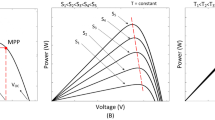Abstract
A quadratic boost converter (QBC) offers a wide range of operations and reduced input current ripple that is suitable for hybrid PV/Wind systems. This paper presents a fast response sliding mode controller with more state feedback for the multi-input QBC system connected to DC micro-grid. The control scheme elaborates on the systematic process of arriving controllable canonical form, the advent of the sliding surface, determination of control law, and explanation of sliding mode existence manifold—the controllable canonical form obtained from state-space equations. The proposed controller ensures a model reference robust dynamics against changing operating conditions, variations of circuit parameters, and external disturbances. Obtained sliding surface satisfy Routh–Hurwitz property, and the switching law maintains the converter in sliding mode. The dynamics are studied using MATLAB/Simulink, and the stability of the system is analysed using the bode plot. A prototype is set up for the two-input QBC, and the experimental results are presented to validate the simulation results.











Similar content being viewed by others
References
AboKhalil AG, Alghamdi A, Tlili I, Eltamaly AM (2019) Current controller design for DFIG-based wind turbines using state feedback control. IET Renew Power Gener 13(11):1938–1949. https://doi.org/10.1049/iet-rpg.2018.6030
Allahverdy D, Fakharian A, Menhaj MB (2019) Back-stepping integral sliding mode control with iterative learning control algorithm for quadrotor UAVs. J Electr Eng Technol 14(6):2539–2547. https://doi.org/10.1007/s42835-019-00257-z
Andrade AMSS, Martins MLDS (2017) Quadratic-boost with stacked zeta converter for high voltage gain applications. IEEE J Emerg Sel Top Power Electron 5(4):1787–1796. https://doi.org/10.1109/JESTPE.2017.2706220
Başolu ME, Çakir B (2016) Comparisons of MPPT performances of isolated and non-isolated DC–DC converters by using a new approach. Renew Sustain Energy Rev 60:1100–1113. https://doi.org/10.1016/j.rser.2016.01.128
El Aroudi A, Giaouris D, Iu HHC, Hiskens IA (2015) A review on stability analysis methods for switching mode power converters. IEEE J Emerg Sel Top Circuits Syst 5(3):302–315. https://doi.org/10.1109/JETCAS.2015.246201310.1109/JETCAS.2015.246201310.1109/JETCAS.2015.2462013
Feng Y, Yu X (2014) Maximum power point tracking control of wind energy conversion systems. Adv Ind Control 9783319084121:49–67. https://doi.org/10.1007/978-3-319-08413-8-3
Fu Q, Nasiri A, Solanki A, Bani-Ahmed A, Weber L, Bhavaraju V (2015) Microgrids: architectures, controls, protection, and demonstration. Electr Power Compon Syst 43(12):1453–1465. https://doi.org/10.1080/15325008.2015.1039098
Monteiro J, Silva JF, Pinto SF, Palma J (2014) Linear and sliding-mode control design for matrix converter-based unified power flow controllers. IEEE Trans Power Electron 29(7):3357–3367. https://doi.org/10.1109/TPEL.2013.2282256
Mukherjee N, Strickland D (2016) Control of cascaded DC–DC converter-based hybrid battery energy storage systems-part I: stability issue. IEEE Trans Ind Electron 63(4):2340–2349. https://doi.org/10.1109/TIE.2015.2509911
Nguyen NT (2018) Model-reference adaptive control Advanced Textbooks in Control and Signal Processing, 2nd edn. Springer, Cham. https://doi.org/10.1007/978-3-319-56393-0
Pinto SF, Silva JFA (1999) Constant-frequency sliding-mode and pi linear controllers for power rectifiers: a comparison. IEEE Trans Ind Electron 46(1):39–51. https://doi.org/10.1109/41.744374
Ranganathan S, Reddy SR, Jamuna V (2013) Modeling and comparison of six switch and three switch single phase to three phase matrix converters. IET Semin Dig 2013(8):137–143. https://doi.org/10.1049/ic.2013.0306
Sharifi Faskhodi A, Fakharian A (2019) Output feedback robust siding mode controller design for wind turbine. J Electr Eng Technol 14(6):2477–2485. https://doi.org/10.1007/s42835-019-00223-9
Su M, Liu Z, Sun Y, Han H, Hou X (2018) Stability analysis and stabilization methods of DC microgrid with multiple parallel-connected DC–DC converters loaded by CPLs. IEEE Trans Smart Grid 9(1):132–142. https://doi.org/10.1109/TSG.2016.2546551
Sullivan CR, Awerbuch JJ, Latham AM (2013) Decrease in photovoltaic power output from ripple: Simple general calculation and the effect of partial shading. IEEE Trans Power Electron 28(2):740–747. https://doi.org/10.1109/TPEL.2012.2205162
Texas Instruments: Switch-mode power converter compensation made easy. Appl. Note, SLUP340 (2016)
Tse KK, Chung HSH, Hui SY (1999) Quadratic state-space modeling technique for analysis and simulation of power electronic converters. IEEE Trans Power Electron 14(6):1086–1100. https://doi.org/10.1109/63.803403
Wen Y, Li G, Wang Q, Guo X (2019) Robust adaptive sliding-mode control for permanent magnet spherical actuator with uncertainty using dynamic surface approach. J Electr Eng Technol 14(6):2341–2353. https://doi.org/10.1007/s42835-019-00273-z
Xia YY, Fletcher JE, Finney SJ, Ahmed KH, Williams BW (2011) Torque ripple analysis and reduction for wind energy conversion systems using uncontrolled rectifier and boost converter. IET Renew Power Gener 5(5):377–386. https://doi.org/10.1049/iet-rpg.2010.0108
Zhang Y, Sun JT, Wang YF (2013) Hybrid boost three-level DC–DC converter with high voltage gain for photovoltaic generation systems. IEEE Trans Power Electron 28(8):3659–3664. https://doi.org/10.1109/TPEL.2012.2229720
Zhong QC, Zhang X (2019) Impedance-sum stability criterion for power electronic systems with two converters/sources. IEEE Access 7:21254–21265. https://doi.org/10.1109/ACCESS.2019.2894338
Author information
Authors and Affiliations
Corresponding author
Ethics declarations
Conflict of interest
The authors declare that they have no conflict of interest.
Additional information
Publisher's Note
Springer Nature remains neutral with regard to jurisdictional claims in published maps and institutional affiliations.
Rights and permissions
About this article
Cite this article
Ranganathan, S., Sathi, R.R. Design and Analysis of Fast Response Sliding Mode Controller for Quadratic Boost Converter based Hybrid PV/Wind System in DC Micro-grid. J. Electr. Eng. Technol. 16, 2561–2571 (2021). https://doi.org/10.1007/s42835-021-00767-9
Received:
Revised:
Accepted:
Published:
Issue Date:
DOI: https://doi.org/10.1007/s42835-021-00767-9




